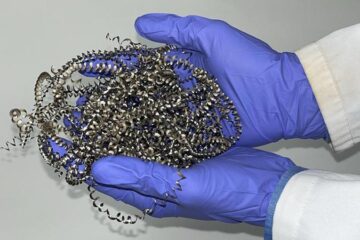MIT model could predict cells' response to drugs Work could lead to targeted therapies

Models based on this approach could help doctors make better treatment choices for individual patients, who often respond differently to the same drug, and could help drug developers identify the ideal compounds on which to focus their research.
In addition, the model could help test the effectiveness of drugs for a wide range of diseases, including various kinds of cancer, arthritis and immune system disorders, according to Douglas Lauffenburger, MIT professor of biological engineering and head of the department. Lauffenburger is senior author of a paper on the new model that will appear in the Aug. 2 issue of Nature.
The model is based on similarities in the signaling pathways cells use to process information. Those pathways translate cells' environmental stimuli, such as hormones, drugs or other molecules, into action.
“Cells undertake behavioral functions-proliferation, differentiation, death-in response to stimuli in their environment,” said Lauffenburger. “The signaling pathways are the biomolecular circuits that process that information from the environment and regulate the mechanisms that execute the behavorial functions.”
The pathways work via a series of signals in which proteins, known as kinases, activate other cell machinery to achieve a specific result, e.g., expression of certain genes, or actions of cytoskeletal proteins. While the same stimuli can produce diverse responses in different types of cells, the researchers believe they can use the same core pathways to achieve various end results.
Lauffenburger compared a cell's strategy to playing a piano: Just as there are 88 keys that can be played in a vast number of combinations to produce different melodies, cells can use their multiple pathways together in many different combinations to produce different behaviors.
One of the key questions that Lauffenburger's group tackled was understanding the way in which cells interpret the signals they receive and how they arrive at the correct result.
The researchers approached the problem quantitatively, measuring activity levels in five major signaling pathways after colon epithelial cells were exposed to a variety of environmental stimuli. The behavioral outcome-cell death, inflammatory cytokine production, etc., was also measured.
Using that data, they constructed a model correlating outcomes with the combined levels of activity in the multiple pathways. The model was then used to correctly predict what would happen to two other types of epithelial cells when exposed to the same stimuli.
“Cells appear to be adding up information across multiple pathways in a common manner, even though the outcome of the calculations is different because the pathway activities are different,” said Lauffenburger.
The researchers also tested the model on a type of blood cell, but in this case, it failed to accurately predict behavioral outcomes. The fact that a model developed with colon epithelial cells only worked for other types of epithelial cells is not surprising because different tissue types process information in different ways, Lauffenburger said.
To develop safe and effective drugs, researchers need to be able to understand how a drug works in the context of a network governing cell functions, not just its effect on an individual molecule. Lauffenburger envisions that drug companies could use this kind of model to test the effects of drugs that inhibit some step in a particular pathway.
The lead authors on the paper are former MIT doctoral students Kathryn Miller-Jensen and Kevin Janes. Joan Brugge, a faculty member at Harvard Medical School, is also an author.
The research was funded by the National Institute of General Medical Sciences Cell Decision Processes Center, the University of California at Santa Barbara-CalTech-MIT Institute for Collaborative Biotechnologies and the MIT Biotechnology Process Engineering Center.
Media Contact
More Information:
http://www.mit.eduAll latest news from the category: Life Sciences and Chemistry
Articles and reports from the Life Sciences and chemistry area deal with applied and basic research into modern biology, chemistry and human medicine.
Valuable information can be found on a range of life sciences fields including bacteriology, biochemistry, bionics, bioinformatics, biophysics, biotechnology, genetics, geobotany, human biology, marine biology, microbiology, molecular biology, cellular biology, zoology, bioinorganic chemistry, microchemistry and environmental chemistry.
Newest articles

“Nanostitches” enable lighter and tougher composite materials
In research that may lead to next-generation airplanes and spacecraft, MIT engineers used carbon nanotubes to prevent cracking in multilayered composites. To save on fuel and reduce aircraft emissions, engineers…

Trash to treasure
Researchers turn metal waste into catalyst for hydrogen. Scientists have found a way to transform metal waste into a highly efficient catalyst to make hydrogen from water, a discovery that…

Real-time detection of infectious disease viruses
… by searching for molecular fingerprinting. A research team consisting of Professor Kyoung-Duck Park and Taeyoung Moon and Huitae Joo, PhD candidates, from the Department of Physics at Pohang University…





















